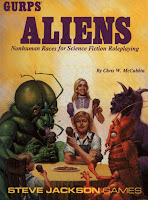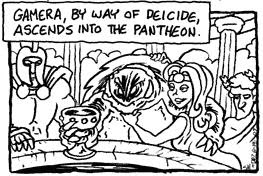The psychosexual gods
Clerics are all perverts, but not in the way you’re thinking.
Let me explain that religion, the act of worship and the belief in gods, is a strictly human proposition. You know how we humans think of dwarves as miners and elves as woodland frolickers? Yet most folks wouldn’t be shocked to meet a dwarfish sign-painter or an elfin sea captain. It’s just that our stereotype is that dwarves are grubby underground pioneers and elves prance around in forests all day. Similarly, most races, dwarves and elves included, secretly stereotype humans as god-worshippers.
And guess what? They think we’re weird. Elves think we’re hilarious, the way members of Western civilization look down at ‘primitive’ beliefs and laugh. All religions look like cargo cults to elves. Dwarves generally think of us the same way a lot of people look at furries. Some dwarves just leave well enough alone, others laugh maliciously at the perverseness of religion, while the dwarven majority just think humans are creepy freaks to be avoided.
Cinder contains many beings that various humans have called gods over the centuries. Maybe a tired old earth elemental sleeping in a mountain finds itself worshipped by local humans. Perhaps a vampire finds itself pacting with its local source of blood and the humans on the other end of the transaction perceive the situation as sacrificing to a rather nasty local deity. Many beings and forces were proclaimed gods by misguided humans.
The advent of the Age of Clerics changed all of that. With the development of a professional class of miracle-working priests false deities could easily be found out. Only True Gods grant their followers divine spells, after all. Still, the work continues in remote regions of Cinder as the clerics of the three faiths seek to eliminate their weaker competition. Once the false gods are sufficiently suppressed perhaps the three true faiths can get around to having a proper religious war. Until then, it is not unknown for clerics of the Church, the Twelve, and the Frog Gods to cooperate in heathen-harrying and idol-smashing.
What remains unknown to all Cinderians is that in many ways the so-called True Gods are less real than the various spirits, monsters, and wizards worshipped in earlier eras. The Twelve Gods are not beings like humans, but more powerful and made of finer substance. The Gold Dragon is not a celestial lizard and the Frog Gods are not amphibians. None of the gods have agency or sentience or will or desires or bodies or thoughts or emotions. Nor do they reside in heavenly abodes, for they do not reside anywhere.
Instead, the True Gods are nothing more or less than psychic manifestations of the untapped sexual energies latent in the human race. The gods represent and embody sum vectors of human psychosexuality, they describe hormonal/psychic trends. The Frog Gods represent the libido unchecked, the id unleashed. The Gold Dragon is symbolic of the sublimation of sexual urges, the overriding of base urges for the good of the community. The Twelve, taken as a whole, are an attempt to mediate between these two extremes.
The act of preparing daily spells is basically the intentional repurposing of sexual energy, the way a steam engine repurposes heat into mechanical energy. The worship of the True Gods charges the batteries that clerics can draw upon. This is why sexual taboos are so important to all three faiths. To not participate in the required orgies is to directly withhold energy from the clerics of the Frog Gods. And Priests of the Gold Dragon are celibate, not because the Dragon commanded it, but because their spells won’t work otherwise. Not that these facts are consciously understood by the clergy, but the most advanced clerics can dimly perceive the direct threat to the faith of sexual impropriety. That’s why the Dragon Pope is always going on about sex outside of marriage, even though he doesn’t really understand his own obsession.
So you can see why the elves think we’re funny and the dwarves find us creepy. Their limited sets of sexual rules are all rationally designed to ensure the perpetuation of the species and clean lines of inheritance. But human clerics seem to make new rules up for no good reason, which looks pretty kinky to outsiders.
The first cleric was a retired prostitute. She wasn’t trying to found a religion, she just wanted to improve her post-professional sex life with some meditation. It all sort of got out of hand after that. In the annals of history it wasn’t the first time a really good orgasm had been mistaken for divine revelation.
 I recommend GURPS Aliens by Chris McCubbin to any GM looking to add some interesting alien races to his campaign. Many of the 20+ aliens included in this tome would make great additions to fantasy worlds. The background info provided on all these dudes fit together like its own jigsaw campaign world. You could seriously run an awesome alien-tastic campaign using your favorite generic or sci-fi rules and this book. Or say you're Traveller PCs manage to misjump their ship off of your campaign map. Just flip open this book and have them appear in a subsector dominated by one of these people.
I recommend GURPS Aliens by Chris McCubbin to any GM looking to add some interesting alien races to his campaign. Many of the 20+ aliens included in this tome would make great additions to fantasy worlds. The background info provided on all these dudes fit together like its own jigsaw campaign world. You could seriously run an awesome alien-tastic campaign using your favorite generic or sci-fi rules and this book. Or say you're Traveller PCs manage to misjump their ship off of your campaign map. Just flip open this book and have them appear in a subsector dominated by one of these people. Do you like cheesy sci-fi and horror flicks from the 50's? Then GURPS Atomic Horror is right up your alley. In addition to standing on its own feet as a source for a quirky B-Movie campaign, this book also makes a great campanion for the sci-fi/horror rpg Spaceship Zero. Author Paul Elliot always struck me as one of the cooler people to hang out at RPGnet. He often went by the handle mithras over there. He's got some very cool stuff on this page.
Do you like cheesy sci-fi and horror flicks from the 50's? Then GURPS Atomic Horror is right up your alley. In addition to standing on its own feet as a source for a quirky B-Movie campaign, this book also makes a great campanion for the sci-fi/horror rpg Spaceship Zero. Author Paul Elliot always struck me as one of the cooler people to hang out at RPGnet. He often went by the handle mithras over there. He's got some very cool stuff on this page. If you haven't read E.E. "Doc" Smith's Lensman series of novels then do yourself a favor and check them out. Lensman IS space opera. It's that effin' simple. You ever heard of the Green Lantern Corps? Howzabout the Jedi Knights? Both were inspired by the Lensmen. And the GURPS adaptation is pretty darn good. I could nitpick an item or two, but I doubt I could do better myself. Golden Age scientifical fictionary adventure at its bestest.
If you haven't read E.E. "Doc" Smith's Lensman series of novels then do yourself a favor and check them out. Lensman IS space opera. It's that effin' simple. You ever heard of the Green Lantern Corps? Howzabout the Jedi Knights? Both were inspired by the Lensmen. And the GURPS adaptation is pretty darn good. I could nitpick an item or two, but I doubt I could do better myself. Golden Age scientifical fictionary adventure at its bestest. GURPS The Prisoner is the best fan-guide-as-rpg-book I've ever seen. Author David Ladyman does an excellent job of providing a meticulous resource for fans of the seminal British TV series while avoiding the common trap of assuming that your game must adhere closely to the licensed property.
GURPS The Prisoner is the best fan-guide-as-rpg-book I've ever seen. Author David Ladyman does an excellent job of providing a meticulous resource for fans of the seminal British TV series while avoiding the common trap of assuming that your game must adhere closely to the licensed property.












